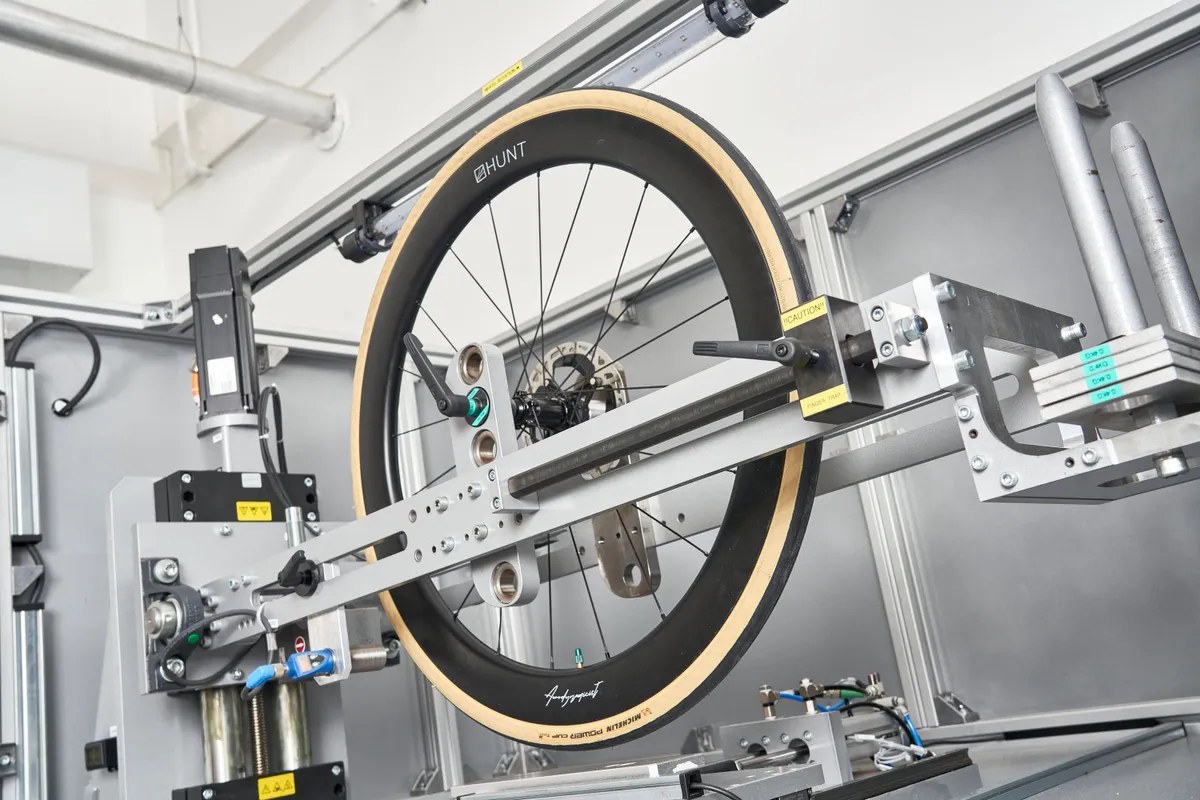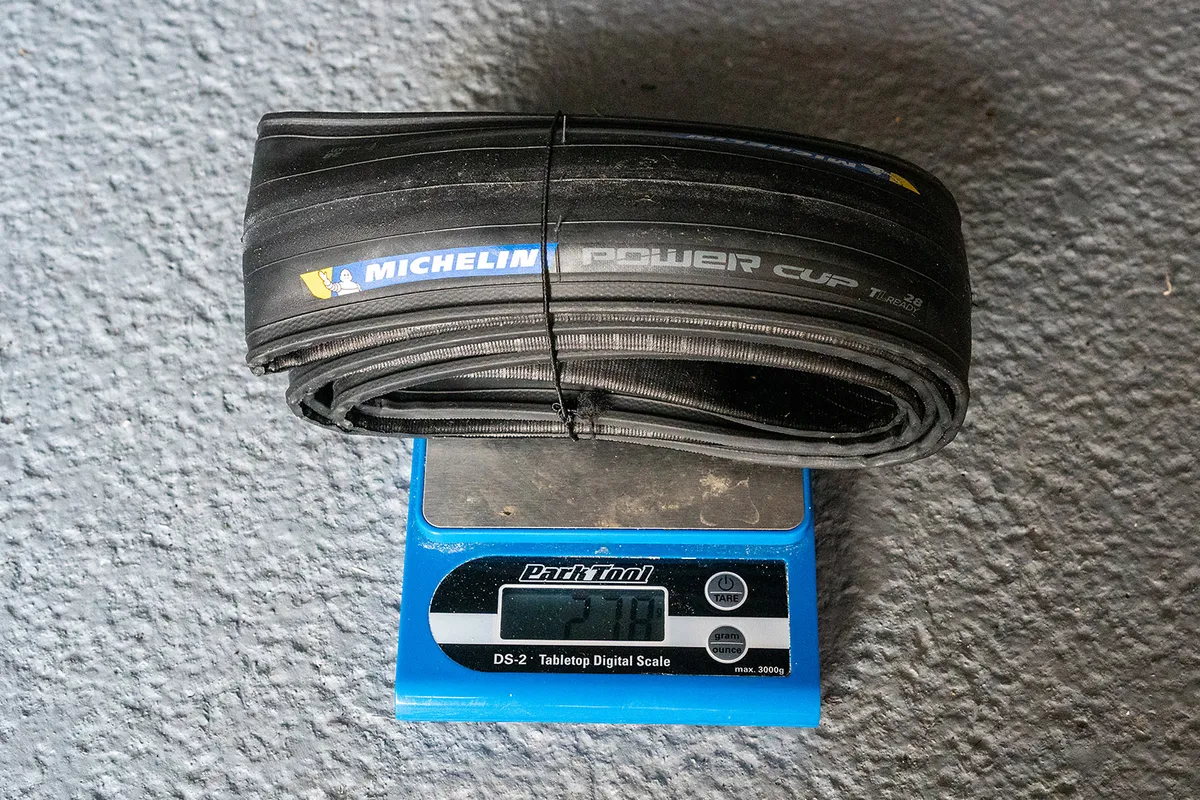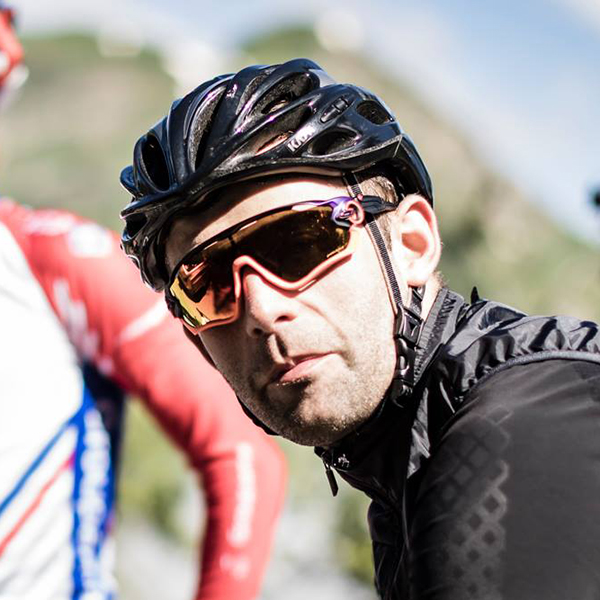The Michelin Power Cup TLR tyre is the French brand’s top-spec tubeless model.
It undercuts many of the latest fast tubeless tyres competing for your custom, which are edging ever closer to the £100 mark per tyre.
The tyre shoots for the usual combination of low rolling resistance and weight, with high levels of grip.
BikeRadar’s own rolling resistance test suggests it’s competitive in this regard, and my overall ride impressions back up the sense that it’s also a consummate high-performance road bike tyre.
As long as you’re prepared to keep a relatively close eye on tyre pressures, there’s little to complain about here.
Michelin Power Cup TLR details and specifications

The Michelin Power Cup TLR tyre is Michelin’s answer to the likes of the Continental GP5000 S TR and Schwalbe Pro One TLE, and many other high-end road bike tyres besides.
Interestingly, Michelin has been comparatively slow on the tubeless uptake – this is currently the brand’s only tubeless option for road use (although given the growing presence of all-season tubeless road tyres, I wonder if that might change soon).
The Power Cup TLR tyre is said to be inspired by MotoGP motorbike tyre technology, featuring a derivative of Michelin’s Gum X compound.
This is claimed to offer low rolling resistance in dry conditions, but deliver good grip in the wet.
The compound’s top surface is totally tread-free. In theory, this maximises any contact patch on the road without disturbance, and enables you to fit the tyre to roll in either direction.
Tyres with a tread pattern typically have directional markers to ensure the correct interaction of tread with the road – the Power Cup TLRs naturally lack this.
Michelin says it provides puncture resistance through its Shield technology (a thin layer through the compound) and a 4x120 TPI (threads-per-inch) casing.

The Power Cup TLR tyre is available in 700x25, 28 and 30c sizes. Black sidewalls come in all sizes, while ‘Classic’ tan sidewalls can be had in the 25 and 28c variants.
My test 28c black tyre weighed in at 278g – as near as makes no difference the same as a GP5000 S TR.
Although £69.99 is by no means cheap, it’s relatively cheap compared to a good swathe of the key competition.
You’ll be expected to part with £10 more for a GP5000 S TR, £9 more for the equivalent Pirelli P Zero Race TLR, and a whopping £20 more for a Vittoria Corsa Pro TLR.
That said, the very good Panaracer Agilest TLR tyre is £10 cheaper, if you’re willing to divert from the usual performance road bike tyre hegemony.
Michelin Power Cup TLR installation and tubeless setup

Setting up the Michelin Power Cup TLR tyre is as easy as I’ve come across to date for a tubeless tyre.
In a rare experience (for me, at least), I was able to get the first tyre over a Hunt 54 Aerodynamicist Carbon Disc wheelset rim without the help of tyre levers.
The other tyre required the help of one lever, but this can potentially be put down to my steadily improving technique.
The tyres popped into place with a few vigorous pumps of a standard track pump.
The tyres inflated to 28.5mm wide at 80psi/5.5 bar for our rolling resistance tests (the widest of the eight-tyre cohort) and 28.4mm when inflated a few psi less than that for my ride testing.
While properly set up and seated, I experience quite high air leakage.

Even with the requisite tubeless sealant installed and an initial shakedown, both tyres almost completely deflated overnight.
This leakage slowed somewhat with subsequent rides (plus one re-seat attempt for the leakier front setup), but I found pressures would nevertheless drop around 5-10psi/0.3-0.7 BAR over the course of a few hours' riding.
Although air leakage is generally more prevalent on tubeless tyres versus clinchers with butyl inner tubes, it’s an annoyance to know that you’re losing a significant amount of tyre pressure over the course of a single ride.
Compare this to my recent experience of the ENVE SES tyres, which proved that it’s perfectly possible for a tubeless tyre to hold its pressure for at least two days without needing to re-inflate it.
Michelin Power Cup TLR rolling resistance

The Power Cup TLR tyres put in a solid performance in our rolling resistance lab test, being the fourth fastest overall.
For a single tyre, the Michelin Power Cup TLR produced 13.15 watts of rolling resistance at 30kph.
That’s just 0.97 watts more than the third fastest tyre, the Challenge Criterium RS and 1.29 watts more than the fastest tyre on test, the Pirelli P Zero Race TLR.

Michelin Power Cup TLR ride impressions
On the whole, I’ve been impressed by the sense of speed and grip the Michelin Power Cup TLR provides.
Although there are tyres that provide even more impressive overall ride feel – the Vittoria Corsa Pro stands out in this regard, while the Pirelli P-Zero TLR and Continental GP5000 S TR are also standard-bearers – the differences are very small.
Our testing revealed the Power Cup TLR to be in the middle of the group when it comes to rolling resistance, and without the benefit of knowing this initially, I got the sense it was competitive with comparable performance tyres I’ve ridden to date.
It’s quiet-rolling up to around 45km/h, after which a roar becomes much more prominent.

I found the tyres generated plentiful grip, impressing especially when I wanted to lean hard on the front wheel on a well-paved descent.
Confidence is key when descending and cornering at speed – the Power Cup TLR helped me build lots of it.
Certainly, once I’d worn through the white out-of-the-mould residue left on a box-fresh tyre (after 50km or so), I felt I could push hard at will.
Naturally, grip levels dropped on wet surfaces, but the compound performed decently here given its high-performance pitching.
On rougher tarmac, I’ve had marginally smoother experiences from the ENVE SES and Continental GP5000 S TR tyres before now, while out of the rolling resistance test cohort, the Goodyear Eagle F1 R was the most impressive in this regard.
Michelin Power Cup TLR bottom line

The Michelin Power Cup TLR delivers almost everything anyone really needs in a high-performance tubeless tyre.
It’s competitively fast according to our lab testing, offers good performance on the road, and manages this while undercutting the majority of its competitors for price.
The obvious downside is the need to check your pressures before every ride, with air leakage proving to be a more obvious issue than I’ve seen on any of the latest-generation tubeless tyres.
However, if you pay attention to tyre pressures and adjust them before every ride anyway, this might be a niggle you can afford to ignore.
Performance tyres | How we tested
We put eight of the latest high-end tubeless road tyres to the test to find out which are worth your hard-earned cash.
To evaluate each tyre, we performed a combination of lab-based and real-world testing.
Our lab testing took place at the Silverstone Sports Engineering Hub, where we used its bicycle-specific rolling resistance rig to determine how efficient each tyre is. All else being equal, a tyre which produces less rolling resistance will enable you to ride faster for the same effort.
We then assessed how easy (or difficult) it was to mount a set of each tyre to rims and set them up tubeless.
Finally, we subjected the tyres to a series of test rides in the real world, to judge their subjective ride quality, grip levels and comfort.
Tyres on test
- Challenge Criterium RS review
- Continental GP5000 S TR review
- Goodyear Eagle F1 R review
- Michelin Power Cup TLR review
- Pirelli P Zero Race TLR review
- Schwalbe Pro One TLE review
- Specialized S-Works Turbo 2BR review
- Vittoria Corsa Pro TLR review
Product
| Brand | michelin |
| Price | 80.00 EUR,70.00 GBP,80.00 USD |
| Weight | 278.0000, GRAM (700x28c) - |
Features
| br_TPI | 480 |
| br_tyreSizes | 700x25c, 700x28c, 700x30c |
